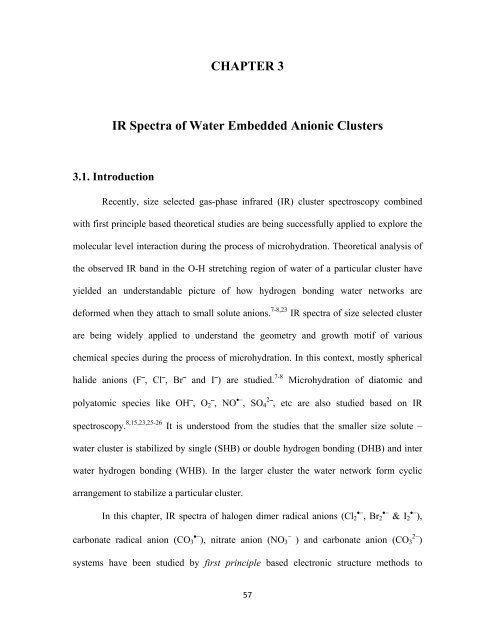CHEM01200604005 A. K. Pathak - Homi Bhabha National Institute
CHEM01200604005 A. K. Pathak - Homi Bhabha National Institute
CHEM01200604005 A. K. Pathak - Homi Bhabha National Institute
You also want an ePaper? Increase the reach of your titles
YUMPU automatically turns print PDFs into web optimized ePapers that Google loves.
CHAPTER 3<br />
IR Spectra of Water Embedded Anionic Clusters<br />
3.1. Introduction<br />
Recently, size selected gas-phase infrared (IR) cluster spectroscopy combined<br />
with first principle based theoretical studies are being successfully applied to explore the<br />
molecular level interaction during the process of microhydration. Theoretical analysis of<br />
the observed IR band in the O-H stretching region of water of a particular cluster have<br />
yielded an understandable picture of how hydrogen bonding water networks are<br />
deformed when they attach to small solute anions. 7-8,23 IR spectra of size selected cluster<br />
are being widely applied to understand the geometry and growth motif of various<br />
chemical species during the process of microhydration. In this context, mostly spherical<br />
halide anions (F⎯, Cl⎯, Br⎯ and I⎯) are studied. 7-8<br />
Microhydration of diatomic and<br />
polyatomic species like OH⎯, O 2 ⎯, NO •− , SO 2 4 ⎯, etc are also studied based on IR<br />
spectroscopy. 8,15,23,25-26 It is understood from the studies that the smaller size solute –<br />
water cluster is stabilized by single (SHB) or double hydrogen bonding (DHB) and inter<br />
water hydrogen bonding (WHB). In the larger cluster the water network form cyclic<br />
arrangement to stabilize a particular cluster.<br />
In this chapter, IR spectra of halogen dimer radical anions (Cl •− 2 , Br •− 2 & I •− 2 ),<br />
carbonate radical anion (CO •− −<br />
3 ), nitrate anion (NO 3 ) and carbonate anion (CO 2− 3 )<br />
systems have been studied by first principle based electronic structure methods to<br />
57
















